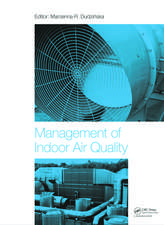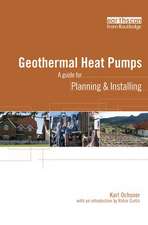Adaptive Thermal Comfort: Principles and Practice
Autor Fergus Nicol, Michael Humphreys, Susan Roafen Limba Engleză Paperback – 16 mar 2012
This timely book is the first in a trilogy from leaders in the field which will provide just that. It explains, in a clear and comprehensible manner, how we stay comfortable by using our bodies, minds, buildings and their systems to adapt to indoor and outdoor conditions which change with the weather and the climate. The book is in two sections. The first introduces the principles on which the theory of adaptive thermal comfort is based. The second explains how to use field studies to measure thermal comfort in practice and to analyze the data gathered.
Architects have gradually passed responsibility for building performance to service engineers who are largely trained to see comfort as the ‘product’, designed using simplistic comfort models. The result has contributed to a shift to buildings that use ever more energy. A growing international consensus now calls for low-energy buildings. This means designers must first produce robust, passive structures that provide occupants with many opportunities to make changes to suit their environmental needs. Ventilation using free, natural energy should be preferred and mechanical conditioning only used when the climate demands it.
This book outlines the theory of adaptive thermal comfort that is essential to understand and inform such building designs. This book should be required reading for all students, teachers and practitioners of architecture, building engineering and management ߝ for all who have a role in producing, and occupying, twenty-first century adaptive, low-carbon, comfortable buildings.
| Toate formatele și edițiile | Preț | Express |
|---|---|---|
| Paperback (2) | 311.26 lei 6-8 săpt. | |
| CRC Press – 16 mar 2012 | 311.26 lei 6-8 săpt. | |
| CRC Press – 14 aug 2020 | 509.50 lei 6-8 săpt. | |
| Hardback (1) | 883.59 lei 6-8 săpt. | |
| CRC Press – 7 sep 2015 | 883.59 lei 6-8 săpt. |
Preț: 311.26 lei
Preț vechi: 356.07 lei
-13% Nou
59.56€ • 63.69$ • 49.66£
Carte tipărită la comandă
Livrare economică 17 aprilie-01 mai
Specificații
ISBN-10: 0415691591
Pagini: 208
Ilustrații: 70 black & white illustrations, 8 colour illustrations, 30 black & white tables
Dimensiuni: 174 x 246 x 10 mm
Greutate: 0.4 kg
Ediția:1
Editura: CRC Press
Colecția Routledge
Public țintă
Postgraduate, Professional, and UndergraduateCuprins
Part 1: Theory ߝ Building an Adaptive Model 1. Thermal Comfort ߝ Why it is Important 2. Thermal Comfort: The Underlying Processes 3. Field Studies and the Adaptive Approach 4. The Heat Balance Approach to Defining Thermal Comfort 5. Standards, Guidelines and Legislation for the Indoor Environment 6. Low Energy Adaptive Buildings Part 2: Practice ߝ Conducting a Survey in the Field and Analysing the Results 7. What Sort of Survey? 8. Instruments and Questionnaires 9. Experimental Method 10. Analysis and Reporting of Field Study Data
Recenzii
Notă biografică
Fergus Nicol has led a number of important research projects on comfort which have influenced thinking internationally. He has authored numerous journal articles and other publications including guidance on comfort and overheating. Fergus convenes the Network for Comfort and Energy use in Buildings and organises their regular international Windsor Conferences.
Michael Humphreys is known for his pioneering work on the adaptive approach to comfort. He has been Head of Human Factors at the Building Research Establishment, and a Research Professor at Oxford Brookes University. His current interests are the structure and modelling of human adaptive behaviour, the interactions between aspects of the environment, and their expression in standards.
Susan Roaf did her PhD on comfort and the windcatchers of Yazd, and after a decade working with Nicol and Humphreys at the Oxford Thermal Comfort Unit she is now Professor of Architectural Engineering at Heriot Watt University in Edinburgh. She is a teacher, researcher, designer and author and editor of 13 books including Ecohouse: A Design Guide and Adapting Buildings and Cities for Climate Change.
.
Descriere
The fundamental function of buildings is to provide safe and healthy shelter. For the fortunate they also provide comfort and delight. In the twentieth century comfort became a 'product' produced by machines and run on cheap energy. In a world where fossil fuels are becoming ever scarcer and more expensive, and the climate more extreme, the challenge of designing comfortable buildings today requires a new approach.
This timely book is the first in a trilogy from leaders in the field which will provide just that. It explains, in a clear and comprehensible manner, how we stay comfortable by using our bodies, minds, buildings and their systems to adapt to indoor and outdoor conditions which change with the weather and the climate. The book is in two sections. The first introduces the principles on which the theory of adaptive thermal comfort is based. The second explains how to use field studies to measure thermal comfort in practice and to analyze the data gathered.
Architects have gradually passed responsibility for building performance to service engineers who are largely trained to see comfort as the ‘product’, designed using simplistic comfort models. The result has contributed to a shift to buildings that use ever more energy. A growing international consensus now calls for low-energy buildings. This means designers must first produce robust, passive structures that provide occupants with many opportunities to make changes to suit their environmental needs. Ventilation using free, natural energy should be preferred and mechanical conditioning only used when the climate demands it.
This book outlines the theory of adaptive thermal comfort that is essential to understand and inform such building designs. This book should be required reading for all students, teachers and practitioners of architecture, building engineering and management ߝ for all who have a role in producing, and occupying, twenty-first century adaptive, low-carbon, comfortable buildings.
















